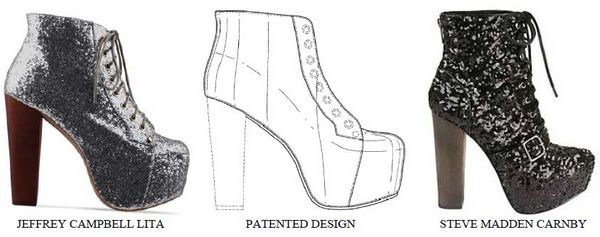Los Angeles, CA – Jeffrey Campbell is taking an aggressive approach to protecting its shoe designs by recently suing Forever 21 for allegedly copying six of its shoe designs. Last week, Jeffrey Campbell filed a new design patent and trade dress infringement and unfair competition lawsuit against Steve Madden for allegedly copying Jeffrey Campbell’s “Lita” shoe design. Although Jeffrey Campbell did not have any patents for the six shoe designs in the Forever 21 lawsuit, it was granted Patent No. D634,532 for the Lita shoe design. Having a design patent provides greater protection for fashion designs than trade dress alone and the causes of action can always be combined, as Jeffrey Campbell has done here. Campbell claims that Steve Madden’s $169.95 Carnby-L shoe design “is believed to be a copy or knockoff of Jeffry Campbell’s Lita Shoe design.” Steve Madden is no stranger to trademark lawsuits involving shoes, having previously settled with Asics for allegedly copying its stripe design.
The patent provides another advantage by keeping copycats away while the product’s configuration attains secondary meaning in the consumers’ minds. Plaintiff contends that since “the release of the Lita Shoe by Jeffrey Campbell in or about the summer of 2010, the internet has been ablaze with, and blogs have raved about,” the shoe design. The significant publicity and promotion of the Lita shoe design has allegedly led to significant sales and acclaim, and widespread public recognition of the Lita Shoe Trade Dress, which is defined as:
The Lita Shoe trade dress is a high-heeled ankle boot with a platform sole. The heel is broad, and it is flat on the side facing the arch and slightly rounded on the remaining sides. The heel tapers down from the upper such that the lower heel portion is about 2/3 the size of the heel portion attached to the upper. The toe portion of the upper is enclosed and extends nearly vertically to the base of the platform sole, and provides an exaggeratedly tall toe portion. The fabric of the upper nearly covers the sole, except for the bottom of the sole, such that the platform portion is covered by fabric. The upper is smooth and close-fitting to the wearer’s foot. Laces extend along the top of the upper from the base of the wearer’s toes to the ankle. The laces tie together the left and right sides of the upper, and the lace holes are surrounded by metallic rivets. The arch portion of the sole includes two separate curves. The curve nearer the heel has its center on the bottom side of the shoe. The curve nearer the toe has its center on the top side of the shoe. The two curved portions blend underneath the wearer’s arch.
To prove trade dress infringement, a plaintiff must show that it was the first to use the design, that the design is exclusively used by the plaintiff, that consumers recognize the design as originating from the plaintiff, that the defendant’s use of the trade dress is likely to cause confusion. On the other hand, design patent infringement does not require proof of consumer recognition of the design and eliminates a lot of cost and expense incurred in consumer surveys. The following Federal Circuit decision provides a great summary of the elements of proof necessary for trade dress versus design patent infringement causes of action:
[T]he difference in weight given to empirical evidence is fully understandable in light of the stark differences between the elements required to show design patent infringement and trademark and trade dress infringement. … [P]urchasers’ likelihood of confusion as to the source of a good is a necessary factor for determining trademark and trade dress infringement. … To show infringement, the holder of a trademark or trade dress therefore must have progressed to the manufacture and distribution of a ‘purchasable’ product. As a result, consumer behavior in the marketplace is a highly relevant factor in determining trademark and trade dress infringement. Since surveys and other empirical studies are ordinarily probative evidence of consumer behavior in the marketplace, such evidence has significance in determining trademark and trade dress infringement. In contrast, … a different quantum of proof applies to design patent infringement, which does not concern itself with the broad issue of consumer behavior in the marketplace. … The single element here required to show design patent infringement involves a much narrower field of inquiry. In short, a design patentee may prove infringement simply by showing that an ordinary observer would be deceived by reason of an accused device’s ornamental design. … Therefore, in showing design patent infringement there is ordinarily no compelling need for empirical evidence. Braun Inc. v. Dynamics Corporation of America, 975 F.2d 815, 828 (Fed. Cir. 1992)
The case is Jeffrey Campbell, LLC v. Steve Madden Ltd., CV11-04836 AHM (C.D. Cal. 2011).
 Los Angeles Intellectual Property Trademark Attorney Blog
Los Angeles Intellectual Property Trademark Attorney Blog


